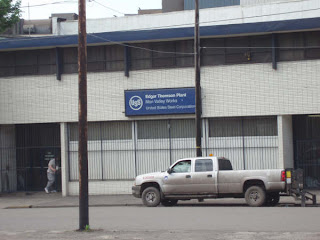
Jennifer and Robert returned the Braddock feral bees that we removed from a derelict building back in April and had requeened, back to their hometown last Friday May 22. We transported them in 5 frame nuc boxes then transferred them to 10 frame hive bodies in the back courtyard of the former St. Michael's convent on Braddock Avenue. The site was overgrown with Japanese knotweed which we made short work of.

The bees seem happy back in the shadow of the Edgar Thompson works across the street.

We also brought another small requeened hive to join the overwintered colony in Hazelwood. The big hive is doing extremely well, so we took a couple frames of emerging brood from the established colony and used them to strengthen the new one. While we have been successfully suppressing the swarm instinct so far by "opening up the brood nest" by removing capped brood, as well as keeping the overhead honey stores broken up, the swarm season hasn't passed, so we continue to monitor the situation.

The bees are finding plenty of nectar and pollen in the river bottom and are packing it in. We added another super of mostly foundation that we dispersed amongst the drawn and filling frames. Taking a tip from a recent issue of American Bee Journal, we put empty medium frames in the middle position of the supers to make cut comb honey. Lastly we made sure to cull the drone brood from the bottom of the drone brood trapping frame we had installed undrawn 4 weeks ago.




